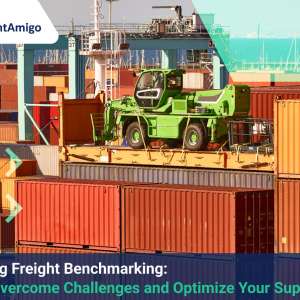Author Name: Tiffany Lee – Marketing Analyst at FreightAmigo
Wharfage is an essential term in the shipping and logistics industry. It refers to the fee charged for the use of a wharf, which is a man-made structure where vessels can safely dock for loading and unloading of cargo. In this article, we will explore the concept of wharfage in detail, including its definition, how it is calculated, and its importance in international trade.
Want To Compare The Best Express, Air Freight, Sea Freight, Rail Freight & Trucking Rates So As To Have Better Control On Cost?
Understanding Wharfage
Wharfage is a fee that is charged by freight terminals or port authorities for the use of their wharf facilities. It is applicable to any shipper or carrier who utilizes the wharf for the movement of their goods. Wharfage charges are incurred twice in the shipping process – once at the port of origin for outbound cargo and again at the destination port for inbound cargo.
It’s important to note that wharfage charges only cover the use of the wharf itself and do not include other service charges such as equipment or labor. These charges are fixed by the port or terminal authorities and are non-negotiable. The amount of wharfage charged can vary depending on the port’s location, volume of trade, and the type of cargo being handled.
Calculating Wharfage Charges
The calculation of wharfage charges can vary depending on the port or terminal authorities. Generally, wharfage charges are based on the weight or volume of the cargo being handled. Some ports may have a flat fee for all types of cargo, while others may have a tiered structure based on the size or value of the cargo.
To calculate the wharfage charges for a specific shipment, it is essential to consult the published rates provided by the port or terminal authorities. These rates can usually be found on the port’s website or obtained from the shipping agent. It’s important for traders to ensure that the charges are billed correctly and comply with the published rates.
Importance of Wharfage in International Trade
Wharfage plays a crucial role in facilitating international trade by providing necessary infrastructure for the movement of goods. Ports serve as vital gateways for imports and exports, and the revenue generated through wharfage charges helps cover the costs of maintaining and operating these facilities.
The amount of wharfage charged can significantly impact a trader’s decision-making process when it comes to selecting ports for their shipments. Busier ports, which tend to have higher wharfage charges, may attract traders seeking faster turnaround times and better connectivity. On the other hand, less-frequented ports may offer lower wharfage fees, making them attractive to traders looking to reduce costs.
Wharfage Charges on Invoices
Wharfage charges may not always be listed separately on the invoice. In some cases, they may be combined with other charges such as the Terminal Handling Charges (THC). It’s essential for traders to review their invoices carefully and ensure that all charges, including wharfage, are accurately accounted for.
In situations where the rates are not available on the port’s website or invoice, traders can request the original bill from their shipping agent. This will provide a detailed breakdown of the charges incurred, including the wharfage fees. It’s important to verify the accuracy of these charges to avoid any discrepancies or overbilling.
Choosing the Right Port
When it comes to selecting a port for your shipments, understanding the wharfage charges associated with each port is crucial. As mentioned earlier, wharfage fees can vary significantly between ports, and this can impact the overall cost of your shipment. It’s important to consider factors such as the volume and value of your cargo, as well as the services and facilities offered by the port.
By carefully evaluating the wharfage charges and comparing them with other factors such as location, infrastructure, and connectivity, you can make an informed decision about which port best suits your business requirements. It’s also worth considering the potential benefits of using less-frequented ports, which may offer cost savings and other advantages.
Conclusion
Wharfage is an important aspect of international trade, ensuring the smooth movement of goods through ports and terminals. Understanding how wharfage charges are calculated, the difference between wharfage and demurrage, and the importance of selecting the right port can help traders make informed decisions and optimize their supply chain operations.
When planning your shipments, it’s crucial to consider the wharfage charges associated with each port and factor them into your overall logistics costs. By doing so, you can ensure that your shipments remain cost-effective and efficient, ultimately contributing to the success of your business in the global marketplace.
There Are Different Options For Cargo Transportation. If You Want To Choose The Most Convenient And Suitable Solution, It Is Best To Have The Full Support Of Logistics Experts! If You Are Planning To Ship Goods Overseas, Please Go To The FreightAmigo Page For Inquiries.
===
Read More:
【Cosmetic Product Recycling】 A Guide to Sustainable Reverse Logistics
【Rise of Green Supply Chain】 Pioneering Sustainable Practices in Logistics
【ESG in Logistics】 How ESG Practices Drive Social Responsibility in Logistics
===
If you have any inquiries on logistics/supply chain, feel free to contact FreightAmigo now:
Chat with us online OR
Phone : +852 28121686
WhatsApp: +852 27467829









































